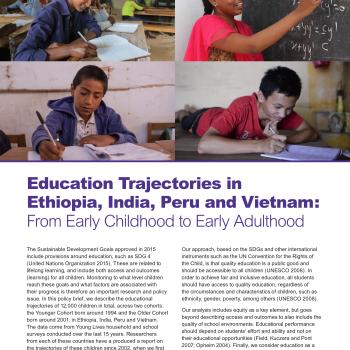Publication Information

Sustainable Development Goal 4, aims to ensure inclusive and equitable quality education and promote lifelong learning opportunities for all’ and includes both access and outcomes (learning) for all children. Monitoring to what level children reach these goals and what factors are associated with their progress is therefore an important research and policy issue.
In this policy brief, we describe the educational trajectories of 12,000 children across two cohorts: the Younger Cohort born around 1994 and the Older Cohort born around 2001, in Ethiopia, India, Peru and Vietnam. The data come from Young Lives household and school surveys conducted over the last 15 years.
Researchers from each of these countries have a produced a report on the trajectories of these children since 2002, when we first started following them.
Here we integrate and summarise some of the main results, highlighting key messages and policy implications for each.
Our approach, based on the SDGs and other international instruments such as the UN Convention for the Rights of the Child, is that quality education is a public good and should be accessible to all children. In order to achieve fair and inclusive education, all students should have access to quality education, regardless of the circumstances and characteristics of children, such as ethnicity, gender, poverty, among others.
Our analysis includes equity as a key element, but goes beyond describing access and outcomes to also include the quality of school environments. Educational performance should depend on students’ effort and ability and not on their educational opportunities. Finally, we consider education as a key factor in the development of individuals, communities and nations, as it increases individual ́s skills, employment opportunities and social mobility, and improves economic growth.

Sustainable Development Goal 4, aims to ensure inclusive and equitable quality education and promote lifelong learning opportunities for all’ and includes both access and outcomes (learning) for all children. Monitoring to what level children reach these goals and what factors are associated with their progress is therefore an important research and policy issue.
In this policy brief, we describe the educational trajectories of 12,000 children across two cohorts: the Younger Cohort born around 1994 and the Older Cohort born around 2001, in Ethiopia, India, Peru and Vietnam. The data come from Young Lives household and school surveys conducted over the last 15 years.
Researchers from each of these countries have a produced a report on the trajectories of these children since 2002, when we first started following them.
Here we integrate and summarise some of the main results, highlighting key messages and policy implications for each.
Our approach, based on the SDGs and other international instruments such as the UN Convention for the Rights of the Child, is that quality education is a public good and should be accessible to all children. In order to achieve fair and inclusive education, all students should have access to quality education, regardless of the circumstances and characteristics of children, such as ethnicity, gender, poverty, among others.
Our analysis includes equity as a key element, but goes beyond describing access and outcomes to also include the quality of school environments. Educational performance should depend on students’ effort and ability and not on their educational opportunities. Finally, we consider education as a key factor in the development of individuals, communities and nations, as it increases individual ́s skills, employment opportunities and social mobility, and improves economic growth.

